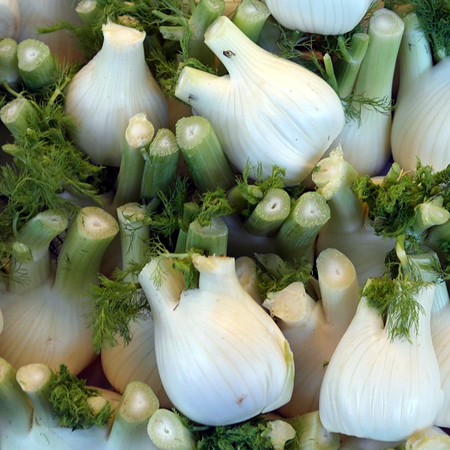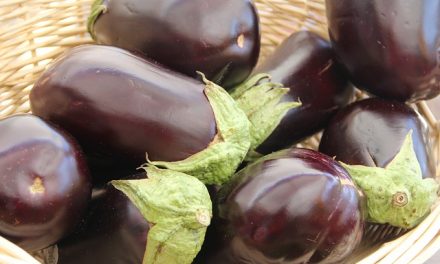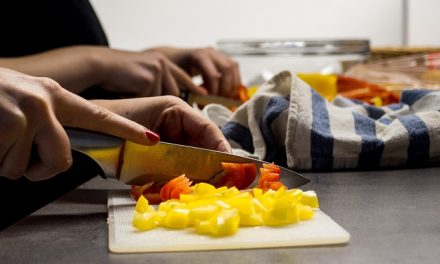When I was growing up, my family, fond of nicknaming foods, dubbed fennel "Pinocchio." We picked this name because it sounds like finocchio, the Italian name for this celery-like white and green vegetable. To my young eyes, fennel looked like the cartoon puppet's elongated nose after he told a lie.
Once an ethnic and seasonal ingredient found only at Italian greengrocers from September to May, fennel now appears in many supermarkets through most of the year. Its distinguishing licorice or anise flavor was considered an acquired "gourmet" taste. Frankly, since it became widely available, I think the chubby bulbs that reach stores are milder tasting than the more pronounced flavor of the fennel I tasted in Italy, France and Greece. For this more intense flavor, check out the slimmer, greener bulbs sold at many farmers markets.
Raw fennel can be fibrous so, if serving it in salads, use a sharp knife to slice it thinly, either vertically or horizontally into thin strips. Cooking quite transforms fennel's flavor and texture. Whether you braise fennel in broth, blanch and then grill it, or simmer fennel in a stew or soup, its licorice taste mellows to a pleasant sweetness with a hint of anise. Cooked fennel loses its fibrousness yet holds its shape no matter how long, or how, it is cooked. In stir-frying or on the grill, it remains white and crisp. But oven-roasted or simmered with liquid, it turns a translucent golden beige that communicates its warm flavor.
Fennel is most often associated with Mediterranean-style dishes, such as this quick saut�, which also includes cannellini beans and chicken. You can also stir-fry it with peppers, red onion, tofu and curry powder. In winter, fennel goes well with root vegetables. For the holidays, try baking thinly sliced fennel layered with sliced apple, sweet potatoes, dried cranberries and cider.
Chicken with Fennel and Red Peppers
Makes 4 servings. (5-1/2 cups)
- 3/4 pound boneless, skinless chicken breast
- 1 Tbsp. extra virgin olive oil
- 1 medium onion, cut in 1/2-inch crescents
- 1 red bell pepper, seeded and cut in 1/2-inch strips
- 1/2 large fennel bulb, or 1 medium, cut lengthwise in 1/2-inch strips
- 1 large garlic clove, finely chopped
- 1 tsp. ground cumin
- 1 can (15 oz.) white beans (great northern, cannellini, trout, etc.) rinsed and drained
- 1/4 cup chopped flat-leaf parsley
- 1/2 cup fat-free, reduced-sodium chicken broth, divided
- 1 Tbsp. white wine vinegar
- Salt and freshly ground black pepper
- Cut chicken into 1/2-inch by 2-inch strips.
- Heat oil in a medium, non-stick skillet over medium-high heat. Cook chicken until white on the outside. Transfer to a plate.
- Add onion, red pepper and fennel to the pan. Stir to coat with oil and juices from the chicken. Saut� 2 minutes. Mix in garlic. Cook until onions and fennel are golden, about 5 minutes, stirring occasionally. Return chicken to the pan. Stir in cumin, beans, parsley, 1/4 cup broth, vinegar and salt. Simmer until chicken is white in the center and vegetables are still al dente, 5 to 6 minutes.
- With a slotted spoon, transfer food to a bowl and keep warm on the side. Mix cornstarch into the remaining broth until well blended. Stir into the liquid in the pan. Heat to a simmer, stirring constantly, until mixture thickens. Return chicken mixture to the pan. Stir until mixture is coated with the sauce and heated through. Season to taste with salt and pepper. Serve with cooked brown rice or roasted potatoes.
Nutritional Information Per Serving:
240 calories,
5 g. total fat (less than 1 g. saturated fat),
23 g. carbohydrate,
25 g. protein,
6 g. dietary fiber,
368 mg. sodium
Diabetic Exchanges: 1 Starch/Bread, 1 Vegetable, 1 Fat
0
AICR







